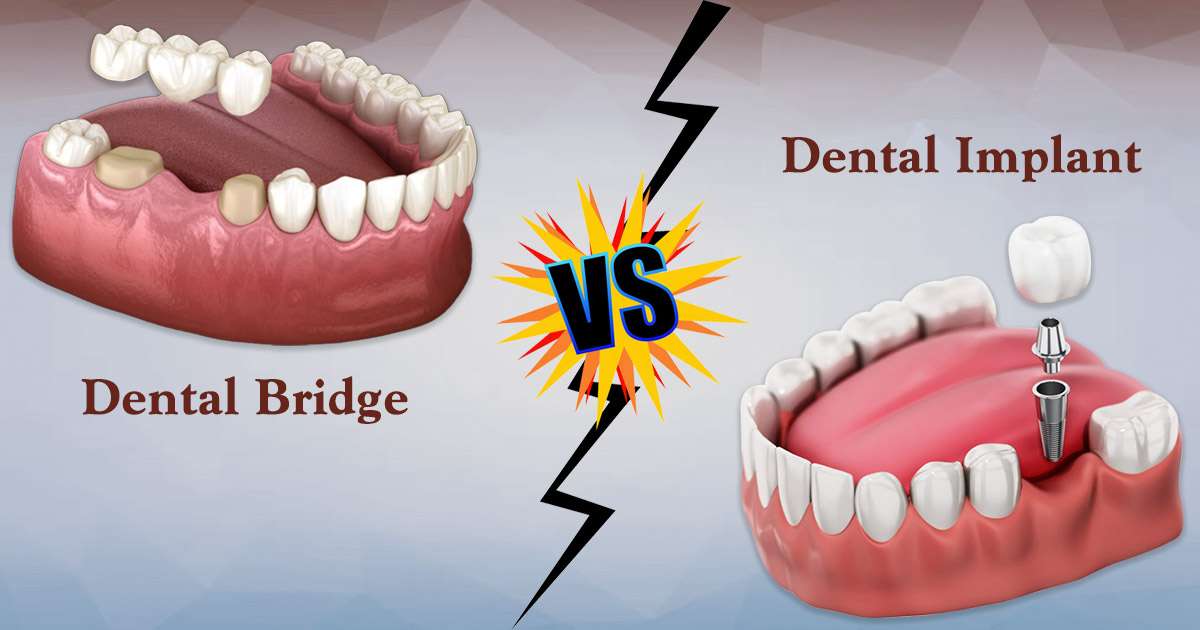Benefits & Disadvantages of Getting a Dental Bridge vs. an Implant

When you lose a tooth, it’s important to replace it to keep your other teeth aligned, maintain your facial shape, and prevent issues with eating or speaking. The two main options for this are dental bridges and implants. Dental bridges are false teeth anchored by neighboring teeth and made from materials like porcelain to blend in with your natural teeth. Dental implants are artificial roots made from titanium that are placed into your jawbone to support a crown or bridge. Let’s look at the dental bridge vs. implant benefits and drawbacks to help you decide which is best for you.
What’s the difference between a bridge and an implant?
Trying to decide between a dental bridge and an implant? Let’s break down the key differences between these two popular tooth replacement options to help you decide which is right for you.
Bridge vs. Implant: Pros and Cons
Dental implants and bridges both offer a way to replace missing teeth that can look just like your natural teeth. But each option has its own pros and cons. Let’s compare them to see how they measure up.
Bridge Pros:
- Usually covered by insurance.
- Doesn’t need bone grafting or major surgery.
- Generally costs less initially than dental implants.
- Typically only needs two dentist visits over a few weeks.
Bridge Cons:
- Needs to be replaced every 5 to 7 years, although it can last more than 10 years.
- Looks less natural as it gets older.
- Causes more cavities and tooth decay in nearby teeth compared to implants.
- Can harm the healthy teeth next to the missing tooth.
Implant Pros:
- Can last 15 years or more, making them the most durable option available.
- Keeps a natural-looking appearance longer than bridges.
- Doesn’t harm the healthy teeth next to the implant.
- Has a success rate of about 97 percent over 10 years.
Implant Cons:
- Insurance is less likely to cover it.
- The process can take up to 6 months.
- Higher initial cost.
- May cause surgical complications.
Bridge vs. Implant Cost
Dental bridges cost less at first than implants, and insurance often covers part of the cost. Prices vary based on:
- Type of implant or bridge
- Material used
- Procedure complexity
- Location
According to the American Dental Association, low-end bridges cost around $500 per tooth, while pricier ones reach up to $1,200. This doesn’t include the cost of attaching crowns, which can range from $500 to $2,500 per tooth.
Implants typically cost $3,000 to $4,500 per tooth, with less insurance coverage. Although implants cost more initially, they age better than bridges and need less frequent replacement.
How to Choose Between a Bridge and an Implant
A dentist can help you pick the best tooth replacement option depending on your budget, how many teeth you’re missing, and your overall health.
Cost
If you have dental insurance, it’s more likely to cover dental bridges than implants. If you don’t have insurance and both are too pricey, think about asking a dentist about partial dentures or other options.
Teeth Missing
If you’re missing several teeth in a row, a dental bridge could be a better option than an implant. Getting an implant for each missing tooth involves surgery on your jawbone, which can be costly and often not practical.
Pre-existing Conditions and Overall Health
Dental implants involve surgery, so they might not be suitable for people with health conditions like diabetes or leukemia that slow down healing. The best people for dental implants are usually healthy and have a strong, healthy jawbone to hold the implant.
Timeline
Getting a dental implant can take several months, while setting up a dental bridge only requires two visits to your dentist over a few weeks. For an implant, an oral surgeon drills into your jawbone and attaches the implant’s root. You might get a temporary denture to wear while your bone heals. Then, you’ll need to wait between 2 to 6 months for your bone to heal before they can put on a crown.
Alternatives to Dental Bridges and Implants
Bridges and implants aren’t the only ways to replace a missing tooth. You can also think about getting partial dentures or space maintainers.
Partial Dentures
Partial dentures, often made from plastic and metal, are used to fill in the spaces where you have one or more missing teeth. They often look like your natural teeth and clip onto your healthy teeth to stay secure. If the teeth next to your missing tooth are too weak for a bridge, a dentist may recommend getting a denture. Although partial dentures are usually cheaper than bridges or implants, they tend to be less comfortable and stable. They can make eating or speaking difficult and need to be cleaned every day.
Space Maintainers
Space maintainers are a good option if you’re not ready to replace a missing tooth immediately. They are typically made of metal pieces that stop the teeth next to the gap from moving.
They are also often used in children to make sure their adult teeth can come in without any blockages.
An orthodontic retainer can also be used to hold the space where teeth are missing, preventing the nearby teeth from shifting into the gap.
Deciding Between Getting a Dental Bridge or an Implant for the Best Smile
If you’re facing the decision of how to replace a missing tooth, consider the benefits and drawbacks of dental bridges and implants. Each has its unique features, and a conversation with your dentist can guide you to the choice that suits your health, budget, and lifestyle best. Remember, taking action now can prevent further dental issues in the future and help maintain your smile’s health and beauty.

